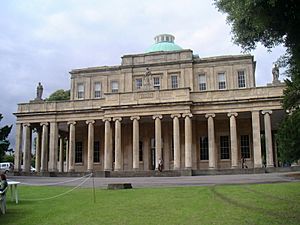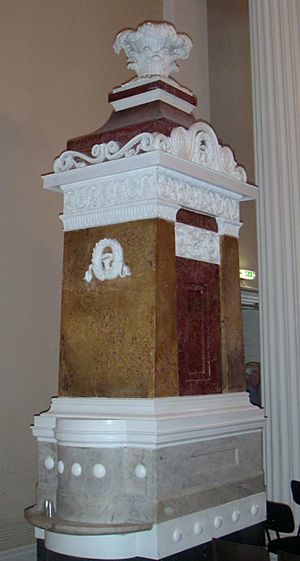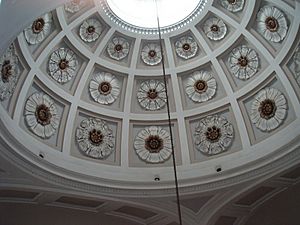Pittville Pump Room facts for kids
The Pittville Pump Room is a grand and historic building in Cheltenham, England. It was the last and largest of the special buildings built for people to drink the town's famous mineral waters. These waters were believed to have health benefits.
Contents
Cheltenham's Famous Waters
People in Cheltenham knew about the special mineral waters as early as 1716. But it wasn't until 1738, when Henry Skillicorne arrived, that people really started to see how popular these waters could become.
A Royal Visit and New Plans
In 1788, King George III visited Cheltenham. After his visit, the town became very fashionable. More wells were opened all around the town for people to try the waters.
Joseph Pitt had a big idea in the 1820s. He planned a whole new part of town called Pittville. The main feature of this new area was the Pump Room. Here, people could drink the mineral waters from one of the wells in the northern part of town.
Building the Grand Pump Room
The famous architect John Forbes designed the Pump Room. It was built between 1825 and 1830. This building is so important that it is a Grade I listed building. This means it's one of the most historically important buildings in the country.
What's Inside the Pump Room?
The Pump Room stands at the northern end of Pittville Lawn. It has lovely landscaped gardens that lead down to a lake. Inside, you can still see the original pump. It's made of marble and a special material called scagliola. Today, electric pumps bring the water to it.
The building has many tall Ionic columns outside. Inside, the ground floor has a large ballroom. More Ionic columns hold up a gallery under a huge dome. Music used to be played from this gallery. On the upper floors, there were rooms for billiards, a library, and a reading room.
Above the columns outside, there are three statues made by Lucius Gahagen in 1827. They show the goddess Hygieia (goddess of health), Aesculapius (god of medicine), and Hippocrates (a famous ancient Greek doctor).
The Pump Room Through the Years
During the 1800s, different people managed the Pump Room and its grounds. They offered fun activities like animal shows, exhibitions, and even hot air balloon rides! However, it was hard to make a lot of money from these activities.
Eventually, Joseph Pitt himself faced financial difficulties. In 1890, the Pump Room and its grounds became owned by the town council.
The Pump Room Today
Today, the Pump Room is part of The Cheltenham Trust. This is a charity that also looks after other important places in Cheltenham. These include the Cheltenham Town Hall, the Wilson Art Gallery & Museum, the Prince of Wales Stadium, and the town's Tourist Information Centre.
The Pump Room is often used for public events. It's a popular place for concerts, especially during the Cheltenham Music Festival. For a while, the upper floor even had a Museum of Fashion.
After some local elections in 2007, there was talk about selling the Pump Room. But many people disagreed with this idea. So, the plan was changed. The building would stay open for public use, but a private group would help manage it.




